

home for-sale how-we-build crokinole crokinole-gallery about-us
Next pageAfter the deck has cured, I rub it out to get a very smooth surface. This process involves wet-sanding the deck multiple times with finer and finer grades of sandpaper, steel wool, and rubbing compounds. This is an area where we experiment with different techniques. I used sandpapers and rubbing compounds for "Mount Doom" and "Red Wolf," but I switched to 0000 steel wool and rubbing compounds for "Cowboy." If you want more information on this process, I suggest you see the chapter "Finishing the Finish" in the classic finishing book "Understanding Wood Finishing" by Bob Flexner.
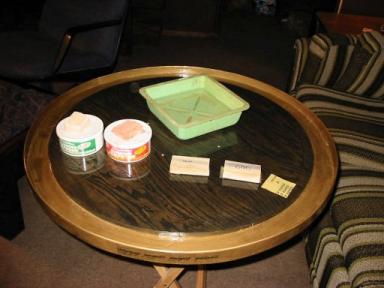 I need a dish of water (soapy water is better), which will be the lubricant.
It is important to use a lubricant when sanding with super-fine papers and steel wool
to keep them from getting clogged with dust. Oils and mineral spirits also work
as lubricants, and I have used olive oil and baby oil with steel wool. I especially
prefer oils to water when I rub out water-based finishes.
I need a dish of water (soapy water is better), which will be the lubricant.
It is important to use a lubricant when sanding with super-fine papers and steel wool
to keep them from getting clogged with dust. Oils and mineral spirits also work
as lubricants, and I have used olive oil and baby oil with steel wool. I especially
prefer oils to water when I rub out water-based finishes.
A piece of 320 sandpaper sits to the far right, which I will use for the first sanding. To its left are two wood blocks to which I have glued 600 grit and 1500 grit sandpaper. Finally, rubbing compound and polishing compound are at the far left.
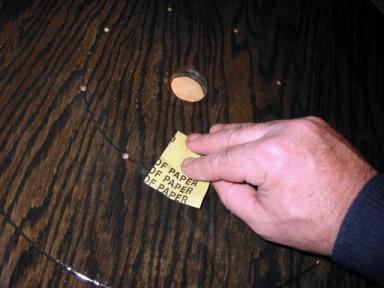 In each step, I wet the deck and the paper before I sand, and then I sand
in the direction of the grain. I count rubs over a spot (5-15 times generally),
so I am consistent across the surface. I sometimes begin with 320 grit if I think
the surface is particularly dirty because I want to remove hairs, dust nibs, and
any other imperfections. This sanding, by the way, will remove the high gloss from
the finish, but it should return as a sheen at the end.
When finished, I wipe off the board of any grit and sludge before I continue.
If I donít like what I see, I sand again. 320 grit is a bit coarse for rubbing out,
so I skip this step if the surface is pretty clean.
In each step, I wet the deck and the paper before I sand, and then I sand
in the direction of the grain. I count rubs over a spot (5-15 times generally),
so I am consistent across the surface. I sometimes begin with 320 grit if I think
the surface is particularly dirty because I want to remove hairs, dust nibs, and
any other imperfections. This sanding, by the way, will remove the high gloss from
the finish, but it should return as a sheen at the end.
When finished, I wipe off the board of any grit and sludge before I continue.
If I donít like what I see, I sand again. 320 grit is a bit coarse for rubbing out,
so I skip this step if the surface is pretty clean.
 I repeat with 600 grit paper, a much finer grit, rubbing in the direction of the
grain. I again wipe it down after I finish. I now start to feel a difference in
the surface. I used 0000 steel wool and oil for "Cowboy."
I repeat with 600 grit paper, a much finer grit, rubbing in the direction of the
grain. I again wipe it down after I finish. I now start to feel a difference in
the surface. I used 0000 steel wool and oil for "Cowboy."
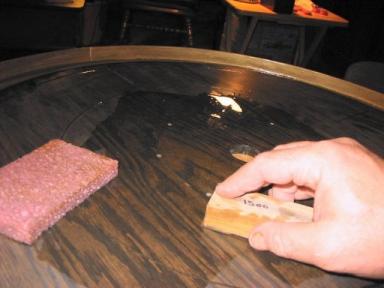 I repeat with 1500 grit paper and wipe it down. The surface is now smooth enough
to play, but I will continue with compounds to bring out the sheen.
I repeat with 1500 grit paper and wipe it down. The surface is now smooth enough
to play, but I will continue with compounds to bring out the sheen.
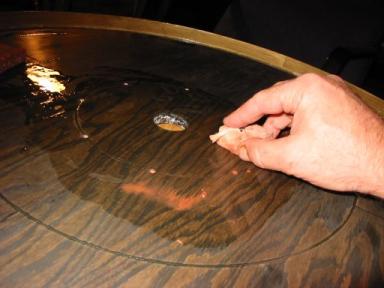 I switch to rubbing compound, which is even a finer grit. I have made tools for
the compounds by wrapping cotton cloth around wood blocks and holding them in
place with tacks. I rub with a damp block. When done, I wipe down the surface
with a clean cloth, and sometimes I use a buffing machine.
These compounds and the very fine grit sandpapers can be found
in most automobile supply stores. The surface now begins to have a sheen.
I switch to rubbing compound, which is even a finer grit. I have made tools for
the compounds by wrapping cotton cloth around wood blocks and holding them in
place with tacks. I rub with a damp block. When done, I wipe down the surface
with a clean cloth, and sometimes I use a buffing machine.
These compounds and the very fine grit sandpapers can be found
in most automobile supply stores. The surface now begins to have a sheen.
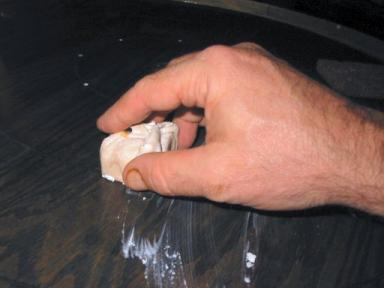 I rub with the polishing compound. This is the final rubbing, so if I am
dissatisfied, I repeat earlier steps. I usually finish by buffing the top with a
buffing machine.
I rub with the polishing compound. This is the final rubbing, so if I am
dissatisfied, I repeat earlier steps. I usually finish by buffing the top with a
buffing machine.
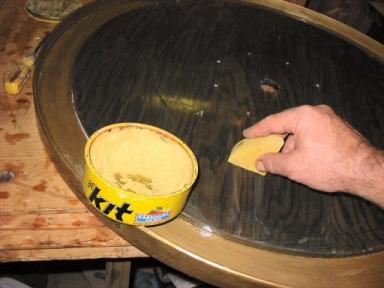 The deck is smooth but not slick. I next apply several coats of car wax following
the product directions. I finish it off with my buffing machine.
The deck is smooth but not slick. I next apply several coats of car wax following
the product directions. I finish it off with my buffing machine.
When we first started making boards, I searched the internet, particularly the woodworking newsgroup archives, for any ideas on how to make our decks more slippery. Most of what I found talked about how to make floors not slippery, but I did find one story from a guy who asked his wife to buy some wax for his newly built dining room table. She brought home car wax, much to his dismay, but he used it anyways. He claimed it looked great, but you had to be careful with the dishes because they tended to fly across the table. Aha! We then experimented with car wax on our board tops and were delighted with the results. We prefer car wax with lots of carnauba wax in it because it seems to be more slippery.